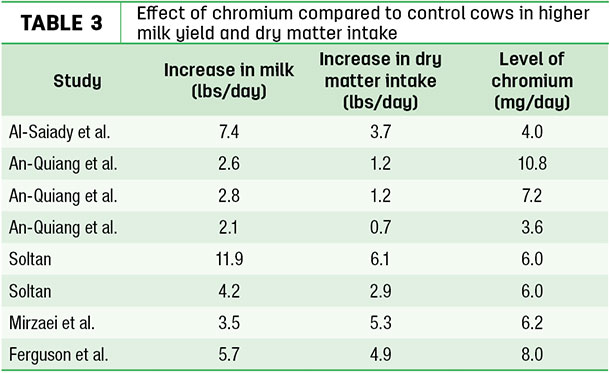Trace minerals continue to be studied and explored in dairy cattle nutrition. Trace minerals do not immediately impact milk yield such as increasing amino acids, added fats and oils, or improved fiber digestibility.
The role of trace minerals include improved enzyme function, stimulation of metabolism, antioxidant source, enhanced immune responses, increased fertility and increased dry matter intake, leading to more milk.
Ohio State researchers list the following nine trace minerals needed by dairy cattle: chromium, cobalt, copper, iodine, iron, manganese, molybdenum, selenium and zinc. A key factor with trace minerals is the level (milligrams) of trace minerals absorbed into the bloodstream to reach target organs (liver, udder and fat reserves, for example).
Mineral antagonists can be a factor that reduce absorption by the animal. (The classic example is: Molybdenum ties up copper absorption.) Nutritionists explore organic trace mineral sources and injectable trace minerals to improve trace mineral bioavailability and cow response.
Role of chromium
Chromium plays an important role in carbohydrate metabolism by stabilizing insulin receptors that allow glucose to enter the cow cell. Glucose is critical for milk lactose synthesis, an energy source for the immune system, and ovarian function along with glucose as an energy source for normal body activity. Ketosis is a shortage of blood glucose leading to mobilization of body fat.
If insulin receptors are not functioning correctly, a condition referred to as insulin resistance can impact the cow (similar to type II diabetic conditions in humans). Studies with dairy cows utilizing a glucose challenge (cows are given large levels of glucose intravenously) have been done to monitor how effectively the cow can clear or use glucose.
Researchers report insulin resistance can occur in close-up dry cows, early lactation and mid-lactation cows compared to late-lactation cows and far-off dry cows.
Chromium effects on cow responses
Researchers report chromium can enhance or improve milk yield, reproduction, immune response and heat stress compared to cows not supplemented with chromium.
Milk yield
Table 1 summarizes 17 studies in peer-reviewed journals with 35 treatment groups comparing milk yield responses and levels of supplemented chromium (range of 4 to 23 milligrams per cow per day with 22 studies at 6 to 10 milligrams per cow per day).

The impact of variable levels of added chromium was not significant. Most chromium treatments reported a positive and significant improvement in milk yield.
Reproduction impact
Negative energy balance in early lactation can negatively impact fertility, which is expressed as lower pregnancy rate and lower conception rate. Some cows will become anestrous, not showing heat when losing excessive bodyweight. Chromium can improve energy balance through reducing insulin resistance and higher levels of glucose.
A field study by the University of Pennsylvania Veterinary College reported an improvement in conception rate, reduction in subclinical metritis, fewer days to first service and an increase in viable oocytes in cows supplemented with 8 milligrams of supplemental chromium.
Immune response
White blood cells are critical for responses to bacterial challenges and cow health. The immune system requires glucose as an energy source for dairy cattle. Research at Cornell University suggests that supplemental chromium enhanced immune responses in early lactation to bacterial challenges in the uterus (Table 2).

Beef cattle researchers report supplemental chromium (400 to 1,000 parts per billion) alleviated the effects of stress in newly arrived cattle to feedlots, reducing blood cortisol, the stress hormone, levels by 64 percent.
Effect on heat stress
Glucose is important in cows experiencing heat stress, according to Iowa State researchers.
Table 3 summarizes five studies with nine treatments on milk response of cows with supplemental chromium and dry matter intake under heat stress compared to non-supplemented or control cows.
Supplementing chromiumon the dairy farm
Supplemental chromium levels in the U.S. are regulated by the FDA. The only supplemental source approved for dairy cattle is an organic source, chromium propionate, allowing up to 500 parts per billion in the final diet. The current cost of adding chromium varies from 6 to 9 cents per cow per day for lactating cows, lower for close-up dry cows as dry matter intake is lower.
The recommended feeding phases are to close-up dry cows, fresh cows and early to mid-lactation cows. A summary of data reported the response to chromium supplementation was 3.7 pounds more milk per day from zero to 30 days in milk, 5.7 pounds of milk per day from 31 to 100 days in milk and 3.7 pounds of milk per cow per day over 100 days in milk compared to control (non-supplemented chromium) cows.
Take-home message
Chromium is a trace mineral that can be beneficial to close-up dry cows, fresh cows and early lactation cows. The legal level of supplemental chromium is 500 parts per billion with a favorable benefit-to-cost ratio of 10 to 1 depending on the price of milk and level of milk response.
Dairy farmers, nutritionists and veterinarians should consider adding chromium to their trace mineral program for higher dry matter intake and milk increase, improved health and immunity, and potential reproduction improvement. ![]()

-
Mike Hutjens
- Professor of Animal Sciences Emeritus
- University of Illinois – Urbana
- Email Mike Hutjens




